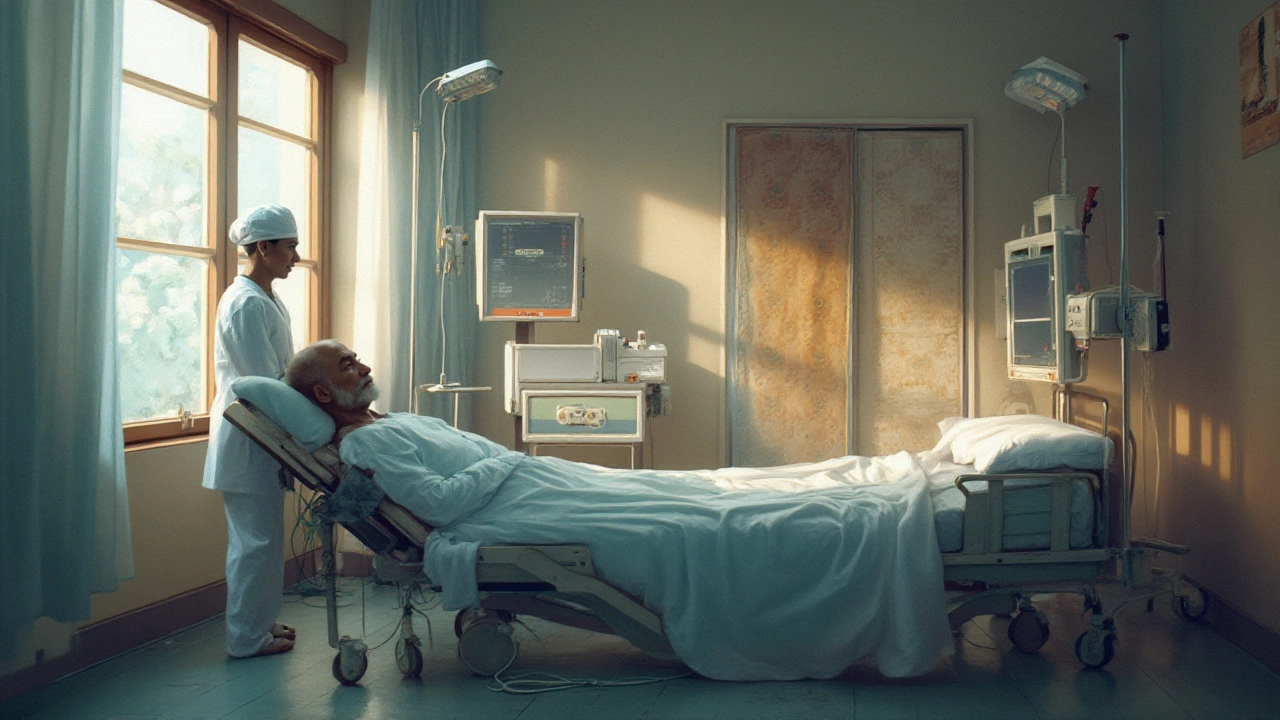
Open-heart surgery sounds like a heavy chapter in one's life, a procedure that’s both intricate and nerve-wracking. For those who have been through it, the road to recovery is often a winding path rather than a straight line. Although the operating room tales might evoke shudders, it’s the journey post-surgery that truly tests the spirit.
A successful surgery is just the start. What follows is a demanding period of healing, adjustments, and sometimes emotional turmoil. While many individuals regain their strength and return to their routines, the recovery experience is deeply personal and varying. Insights into this journey can empower patients, equipping them with the knowledge needed to take on the challenges ahead with confidence and hope.
Let's unravel the layers of recovery, offering practical advice and real stories to paint a picture of resilience and hope that defines this remarkable journey.
- The Nature of Open-Heart Surgery
- Immediate Post-Surgery Recovery
- Physical and Emotional Challenges
- Role of Cardiac Rehabilitation
- Long-Term Health Adjustments
- Patient Stories and Testimonials
The Nature of Open-Heart Surgery
Open-heart surgery is a fascinating yet highly demanding medical procedure that transforms the lives of about a million patients each year globally. The very term evokes images of surgical precision and crucial, life-changing interventions. At its core, open-heart surgery involves opening the chest cavity to perform surgery on the heart muscles, valves, arteries, or other related areas. Generally, the patient is connected to a heart-lung bypass machine, which temporarily takes over the heart's pumping action and oxygenates the blood. This allows the surgeon to operate on a still heart. While advancements in technology and medicine have significantly improved the success rates, the complexity of the procedure remains formidable. The reason for undertaking such extensive surgery usually includes coronary artery bypass grafting, valve replacements, and repair of congenital heart defects among others.
The intricate nature of this procedure demands a team of expert medical professionals, each with a critical role to play. From the anesthesiologist who ensures the patient remains safely anesthetized, to the perfusionist managing the heart-lung machine, every member of the team is crucial. The procedure could take anywhere from 3 to 6 hours, depending heavily on what needs to be corrected within the heart. A prevailing notion is that once you've undergone open-heart surgery, you discover a profound sense of admiration for medical science. Not everyone realizes the physical or emotional preparedness this surgery requires. As Dr. John Warner of the American Heart Association puts it,
“Open-heart surgery is a journey of not only physical healing but of great emotional and psychological transformation.”It's an intricate dance of skill, technology, and careful recovery planning that begins long before operating robes are donned.
Navigating the intricacies of heart surgery recovery begins with understanding what exactly happens under the surgeon's skilled hands. The redness of the chest incision isn't just a cut; it's a gateway to a renewed chance at life. Despite the advancements, every procedure carries potential risks which could include infection, stroke, or arrhythmia. As daunting as these may sound, for many, it is the hope of overcoming life-threatening heart issues that drives the decision to proceed. Often, the success of open-heart surgery depends not just on the surgery itself but also on the care received post-procedure. This is a journey not taken lightly but with a leap of faith backed by medical expertise. Being informed and prepared for the complexities of this surgery can help patients embrace the challenges they will face on the road to recovery.
A nuanced understanding of this surgical marvel assists not only patients but also their families. It prepares them for the painstaking yet rewarding journey towards healing. Encountering stories of individuals who have successfully trodden this path can be a source of inspiration and strength. Appreciating the profound nature of open-heart surgery changes the narrative from apprehension to optimism and empowerment. The end goal remains a healthier heart, a new lease on life, and becoming living, beating testimonies of hope and resilience.
Immediate Post-Surgery Recovery
At the helm of the post-surgery journey stands the initial phase, the culmination of exhaustive surgeries and meticulous planning—the moment when patients first wake up in the intensive care unit. Here, the body starts its journey to mend and rebuild. During this time, the medical team transitions focus from the operation itself to ensuring that everything proceeds smoothly as healing begins. In the initial days, many find themselves surrounded by a web of wires and monitors, all doing the silent work of safeguarding health and providing crucial information to medical staff.
There's a whirlwind of sensations; from the beep of heart monitors to the sterile smell of the hospital room. Patients will find that nurses frequently check their vital signs and manage drips to ensure steady fluid levels. With open-heart surgery, the recovery is very much a day-by-day endeavor. Pain management is a critical element, with tailored plans ensuring discomfort is kept in check, allowing patients to breathe easier and focus on healing. "The first few days are essential for setting the trajectory towards recovery," explained Dr. Sarah Wells, a renowned cardiologist. Progress might be measured by very minuscule achievements, like sitting up in bed or taking those tentative first steps with assistance, but every small victory lays the foundation for more significant gains.
In this phase, nutrition also plays a pivotal role. Patients are typically encouraged to gradually reintroduce meals into their routines, beginning with light, easily digestible foods that won’t place undue stress on the system. Complications like infections, though rare due to stringent practices, remain something doctors vigilantly monitor. As visitors stream in and out with positive vibrations and well-wishes, the real stars of this period tend to be the recovery nurses and therapists who guide families and patients. They provide educational insights and practical tips on managing fluid intake, recognizing warning signs, and understanding medication.
Many patients often rave about the renaissance of humility and gratitude that follows such an invasive procedure. This recovery period is an opportunity for reflection, gathering resolve, and setting ambitions for the road to come. With assurance and careful guidance, these early days are all about establishing a solid base, ensuring that the healing process is as straightforward and effective as possible, allowing the heart to not just repair but come back stronger.
Physical and Emotional Challenges
Enduring an open-heart surgery is not just a physical trial; it casts a significant shadow on one’s emotional well-being. The journey from the operating table to a full recovery often feels like navigating through an uncharted labyrinth. Despite the medical advancements ensuring safer and more precise procedures, the aftermath of surgery is a testament to human resilience. Physically, patients are likely to face a continuum of discomforts ranging from incision pain to unexplained fatigue. The body, which largely relied on its biological rhythms, suddenly finds itself recalibrating. This phase is demanding because healing requires both time and energy that challenge a person's stamina.
On the emotional front, it's not uncommon to encounter bouts of anxiety and depression. This surgery often triggers a cascade of emotions, including fear of recurrence and uncertainty about the future. According to the American Heart Association, roughly one out of every four patients experiences depression after major heart surgery. Emotions run high, and support becomes indispensable. Patients need not traverse this daunting path in solitude; instead, reaching out to psychological support groups fosters communal healing.
Dividing these aspects into tangible steps is crucial for practitioners and patients alike. Patients are encouraged to follow specific physical rehabilitation guidelines. A typical plan might involve scheduled physical exercises such as walking or other gentle cardiovascular activities, which should be introduced gradually. This measured approach not only aids the recovery process but also improves the emotional worries that accompany the lack of physical activity. However, the success of these routines greatly depends on an individual’s pre-existing health status, the complexity of the surgery, and their mental preparedness.
Emotional resilience is as essential as physical recovery, forging the way for genuine healing. Dr. Stuart Katz, a notable cardiologist, in his interview with HeartMatters Magazine stated,
"The interplay between mindset and healing is profound; nurturing one’s spirit can greatly influence physical recuperation."This means creating environments where patients feel valued and understood is critical. Not only does it help in ameliorating emotional pain, but it also acts as a courageous leap towards rebuilding shattered expectations.
It's worth emphasizing the importance of tailored support plans. Caregivers are essential in ensuring that the cardiac rehabilitation encompasses both physical and emotional dimensions. Regular updates from healthcare providers, discussions with peers who have had similar experiences, and active engagement in therapeutic activities can foster healing. By facing these challenges with informed strategies, patients can return to life with renewed vigor. In essence, embracing these hurdles is integral to the path towards not just surviving but thriving post-surgery.

Role of Cardiac Rehabilitation
The journey to recovery after an open-heart surgery is significantly shaped by the role of cardiac rehabilitation. This specialized program isn't merely a set of exercises; it's a comprehensive plan aimed to restore your physical and emotional state. When you hear about rehabilitation, you might just think of people lifting weights or running on treadmills, but in the context of heart surgery recovery, it's much more profound. A team involving doctors, nurses, exercise specialists, therapists, and nutritionists come together to soundtrack your path to a healthier heart.
So why is cardiac rehabilitation pivotal? It's crucial because it helps patients regain strength, manage symptoms effectively, and reduce the risk of subsequent heart issues. Research reveals that participation in cardiac rehab can cut the risk of another heart attack by more than 20%. This figure alone speaks volumes. The structured activities are not just focused on physical recovery, but also help in adopting lifestyle changes that contribute to long-term health adjustments—a key effort in preventing future complications. These all-around efforts help consolidate the healing process, providing a framework that supports medical recovery with lifestyle refinements.
The Components of Cardiac Rehabilitation
The program usually spans around 12 weeks but may vary depending on individual situations. It entails several key components, each focusing on enhancing specific aspects of your recovery. Exercise training, for instance, is tailored to suit your specific health condition. You will be guided through exercises that enhance cardiovascular health, improve flexibility, and build muscular strength. Do you remember the last week you did those morning stretches before life took over? Well, cardiac rehab gently integrates such routines back into your life.
Education is another pillar of cardiac rehab: knowing what type of food to eat, how to maintain weight, and uncovering the unseen stressors in your life are pivotal factors. Nutritionists work alongside you to carve out dietary habits that nourish your recently mended heart. Educational sessions frequently involve strategies for effectively quitting smoking or managing stress, both of which are vital. In fact, a recent UK Health Statistics report indicated that patients who attended rehab programs saw a significant decrease in stress-related symptoms by around 30%.
Monitoring progress is another significant dimension. Imagine the ease when someone is keeping a tab on your vitals like blood pressure, sugar levels, and cholesterol regularly. Medical check-ups are frequent in rehab programs, offering you and the team valuable insights on how well your heart is adapting to the new lifestyle changes. Importantly, this prompt monitoring means quick responses to any early indicators of trouble. This layered approach ensures that any incongruences during recovery are swiftly addressed.
Cardiac rehabilitation isn't just a one-track medical intervention. It's a blend of companionship and guidance, a support network tailored for heart surgery recovery. Let’s not underestimate the companionship in such programs. Finding people who have walked the same path offers emotional solace. It creates an atmosphere where hope and motivation tether, encouraging patients to adhere to treatment plans and share experiences. As Dr. Samantha Turner from the Birmingham Cardiac Institute asserts,
“The combined medical and moral support patients receive through cardiac rehabilitation is unparalleled in effect.”
Building a Sustainable Future
The reaching arms of cardiac rehabilitation stretch long into the future. Setting you on a path for a heart-healthy future is the ultimate goal. While the 20% reduction in recurrent heart-attacks is the immediate advantage, the actual benefits go beyond numbers. Sustaining physical activity, improved dietary habits, stress relief, and the companionship of fellow survivors, all contribute to a richer, more fulfilling lifestyle post-surgery. The ability to re-engage with family activities without the looming stress of the previous health scare is the truest testament to the effectiveness of cardiac rehabilitation.
Long-Term Health Adjustments
Once the hospital discharge papers are signed, many patients who have undergone open-heart surgery find themselves stepping into the arena of long-term health adjustments. This phase is critical because it defines the quality of life moving forward. One fundamental aspect involves making lifestyle changes, including dietary modifications. A heart-friendly diet is not just a suggestion; it's an absolute necessity. Reducing sodium intake, shying away from saturated fats, and embracing a diet rich in fruits, vegetables, whole grains, and lean proteins are paramount strategies. These nutritional shifts can profoundly impact cholesterol levels and lower blood pressure, enhancing heart health.
Exercise, often viewed as a magic bullet for multiple health issues, plays a pivotal role here. Under medical guidance, a balanced exercise regime helps to rebuild strength, improve circulation, and boost mood. The type of exercise and its intensity is typically tailored to each individual’s capacity and current health status. Regular walks, for instance, are a simple yet effective way to keep the heart active without exerting undue stress. Some patients, inspired by their progress, even take up aerobic exercises or swimming as they continue to heal.
It’s worth mentioning that some patients might find solace in support groups or community initiatives. These spaces offer emotional support and practical advice, sharing experiences that resonate with others who have traveled or are traveling the same path. "The journey to optimal wellness doesn't happen in isolation," shares Dr. Lina Rosenberg, a well-respected cardiologist, highlighting the importance of community support in the recovery process. Many find that engaging with fellow survivors brings a sense of camaraderie and understanding that is both comforting and motivating.
Regular follow-ups with healthcare providers remain another cornerstone of long-term health management. During these visits, medical professionals monitor heart function, medication efficacy, and overall health parameters. It’s an opportunity to make adjustments to medications and get valuable insights into managing day-to-day health challenges. Over time, these check-ins often become less frequent, but their impact on sustained recovery cannot be overstated.
To better visualize the benefits of long-term adjustments post-surgery, let’s consider some statistics. Studies have shown that patients engaging in cardiac rehabilitation programs and maintaining a heart-healthy lifestyle tend to observe a 35% reduction in the risk of myocardial infarction when compared to those who don't adapt similar practices.
| Factor | Impact on Recovery |
|---|---|
| Dietary Adjustments | Significant cholesterol reduction |
| Regular Exercise | Improved cardiac efficiency |
| Social Support | Enhanced psychological resilience |
The journey after heart surgery recovery involves integrating these adjustments into everyday life. It's a continuous process of learning, adapting, and evolving to stay ahead of potential health hiccups. Those who embrace these changes holistically often find themselves living a life not just free from the shadows of surgery but defined by newfound vigor and appreciation for well-being.
Patient Stories and Testimonials
When it comes to recovering from open-heart surgery, each individual's story paints a vivid picture of resilience and transformation. These narratives are testimonies of courage, crafting an inspiring quilt of experiences that showcase the human spirit's capacity to heal and adapt. Meet Sarah, a 52-year-old teacher who underwent surgery for a blocked aortic valve. Sarah talks about the surreal moment she woke up in the ICU, seeing a blur of medical staff and feeling like she was in two worlds at once. Her recovery began with tiny steps – physically, when she was encouraged to move from bed to chair, and emotionally, as each small victory kindled hope within her.
Then, there's Jonathan, a former marathon runner whose life was oriented around motion. Post-surgery, Jonathan faced a profound realization: he had to redefine what movement meant to him. Initially, he felt like a bird with clipped wings, confined and powerless. However, as he engaged in cardiac rehabilitation, he discovered new freedoms and aspirations, learning to embrace patience and self-compassion. Cardiac rehab provided him not only with physical benefits but also a community. "It was like finding a family," Jonathan reflects. In fact, according to a study from the British Heart Foundation, patients who participate in cardiac rehabilitation show a reduced rate of subsequent cardiac events by up to 31%.
From Struggle to Strength
The emotional landscape of recovery can't be overstated. Many patients encounter this through the story of Oliver, a retired engineer who expresses feelings of vulnerability when his health slipped out of his control. As Oliver recounts, "It was like my heart was telling me a story, one that I had to listen to very closely." The healing wasn't merely physical; engaging with his emotions allowed Oliver to develop a sincere understanding of his needs and limits. For Oliver, sharing his feelings in support groups was transformative, where others shared similar experiences and anxieties. Support groups have been statistically shown to improve emotional health, adding a layer of emotional resilience crucial for long-term recovery.
Moreover, consider the journey of Leah, an individual whose sensitivity to her body became her greatest ally. Leah found strength in meditation and breathing exercises, which she says were akin to polishing a tarnished gem hidden within. "Every breath was a way of letting my heart know it was okay to be vulnerable," she said, quoting renowned heart specialist Dr. Rita Redberg:
"Embrace each breath for what it is: a note in the ongoing symphony of healing."This mindset helped Leah cultivate patience, a quality crucial for appreciating small health gains and fostering a positive outlook.
Each of these stories underscores how the recovery journey is more than a sequence of medical milestones. It is a complex, deeply personal metamorphosis. Patients like Sarah, Jonathan, Oliver, and Leah remind us that while the body heals, it’s equally significant for the heart to find its rhythm emotionally. This synthesis of physical and emotional recovery enforces a refreshing perspective: the path to healing is not a race, but a journey marked by new choices and renewed hope.





Rohan Talvani
I am a manufacturing expert with over 15 years of experience in streamlining production processes and enhancing operational efficiency. My work often takes me into the technical nitty-gritty of production, but I have a keen interest in writing about medicine in India—an intersection of tradition and modern practices that captivates me. I strive to incorporate innovative approaches in everything I do, whether in my professional role or as an author. My passion for writing about health topics stems from a strong belief in knowledge sharing and its potential to bring about positive changes.
view all postsWrite a comment